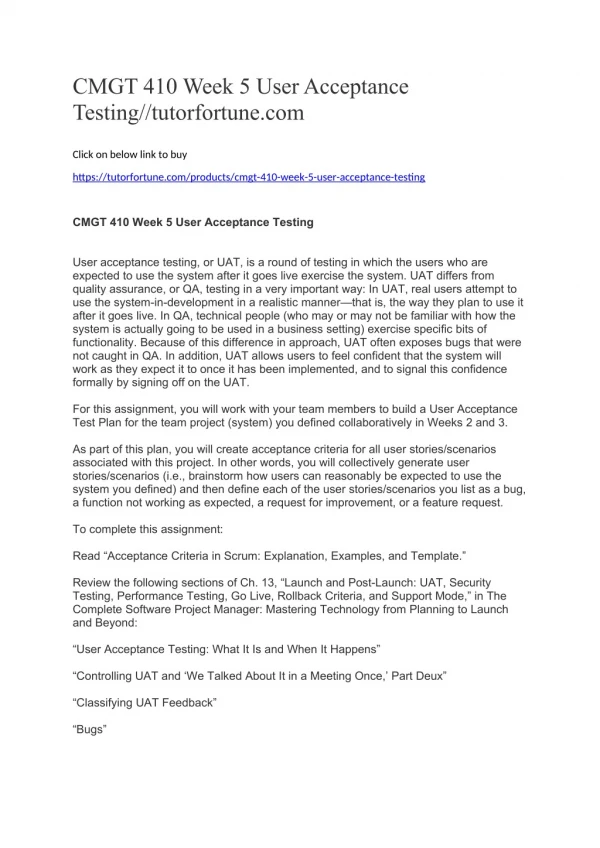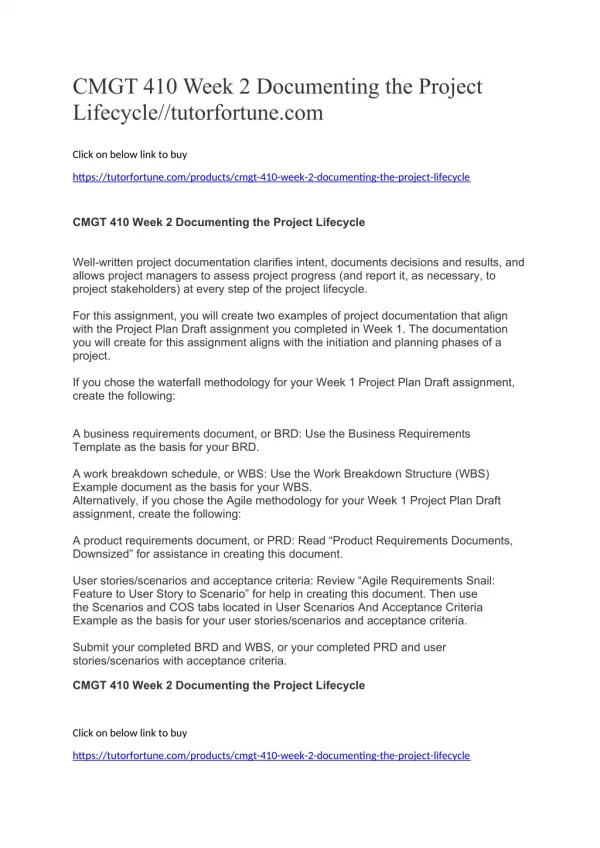CMGT 410 Week 5 User Acceptance Testing//tutorfortune.com
CMGT 410 Week 5 User Acceptance Testing//tutorfortune.com Click on below link to buy https://tutorfortune.com/products/cmgt-410-week-5-user-acceptance-testing CMGT 410 Week 5 User Acceptance Testing User acceptance testing, or UAT, is a round of testing in which the users who are expected to use the system after it goes live exercise the system. UAT differs from quality assurance, or QA, testing in a very important way: In UAT, real users attempt to use the system-in-development in a realistic manneru2014that is, the way they plan to use it after it goes live. In QA, technical people (who may or may not be familiar with how the system is actually going to be used in a business setting) exercise specific bits of functionality. Because of this difference in approach, UAT often exposes bugs that were not caught in QA. In addition, UAT allows users to feel confident that the system will work as they expect it to once it has been implemented, and to signal this confidence formally by signing off on the UAT. For this assignment, you will work with your team members to build a User Acceptance Test Plan for the team project (system) you defined collaboratively in Weeks 2 and 3. As part of this plan, you will create acceptance criteria for all user stories/scenarios associated with this project. In other words, you will collectively generate user stories/scenarios (i.e., brainstorm how users can reasonably be expected to use the system you defined) and then define each of the user stories/scenarios you list as a bug, a function not working as expected, a request for improvement, or a feature request. To complete this assignment: Read u201cAcceptance Criteria in Scrum: Explanation, Examples, and Template.u201d Review the following sections of Ch. 13, u201cLaunch and Post-Launch: UAT, Security Testing, Performance Testing, Go Live, Rollback Criteria, and Support Mode,u201d in The Complete Software Project Manager: Mastering Technology from Planning to Launch and Beyond: u201cUser Acceptance Testing: What It Is and When It Happensu201d u201cControlling UAT and u2018We Talked About It in a Meeting Once,u2019 Part Deuxu201d u201cClassifying UAT Feedbacku201d u201cBugsu201d u201cNot Working as Expected u2013 The Trickiest Categoryu201d u201cRequest for Improvementu201d u201cFeature Requestu201d u201cConflict Resolution and Final Launch Listu201d As a group, complete the COS sheet portion of the linked UAT Plan Template. Note: Click theCOS tab that appears at the bottom of the spreadsheet to see the COS sheet. COS stands for Conditions of Satisfaction/Acceptance Criteria. Save your collaboratively completed UAT plan template using a unique file name that does not include the string u201cTemplateu201d. Submit the team assignment. CMGT 410 Week 5 User Acceptance Testing Click on below link to buy https://tutorfortune.com/products/cmgt-410-week-5-user-acceptance-testing
★
★
★
★
★
34 views • 2 slides

